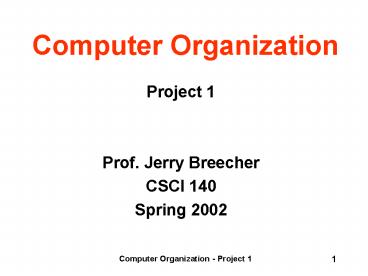Computer Organization - PowerPoint PPT Presentation
1 / 12
Title:
Computer Organization
Description:
... my webpage see the bottom of the page at http://babbage.clarku.edu/~jbreecher ... http://babbage.clarku.edu/~jbreecher/comp_org/lectures/AppendixA-SPIM.ppt ... – PowerPoint PPT presentation
Number of Views:55
Avg rating:3.0/5.0
Title: Computer Organization
1
Computer Organization
- Project 1
- Prof. Jerry Breecher
- CSCI 140
- Spring 2002
2
What You Will Do In This Lab.
- The purpose of this lab is to help you become
familiar with simple Assembler programs and the
use of SPIM, the hardware simulator. This means
being able to do editing, and Spimming of these
programs. - You have one task before you
- 1. Using your favorite editor, type in (or
paste) the program given later in this document.
Assemble it and run it and show that it produces
the result you would expect.
3
What You Will Do In This Lab.
- Groundrules
- Credit for Labs and Projects comes in two
flavors - Showing up for lab (at the appointed hour) gets
you credit for lab. - Doing the project (whether during the lab hour or
at some other time), and satisfying me that it
works gets you project credit. - For this weeks lab/project, you will conduct the
project as described on a page later in this
document. - You will get checkoff credit when I see that it
works and produces the results we know its
supposed to have.
4
Where To Get Documentation
- There are many sources of information to help you
with this lab. Here are some of those sources - Learning UNIX
- These skills can be acquired (I hope) from the
documentation available on my webpage see the
bottom of the page at http//babbage.clarku.ed
u/jbreecher - SPIM can best be learned from the summary lecture
at - http//babbage.clarku.edu/jbreecher/comp_org/lect
ures/AppendixA-SPIM.ppt - Along with Appendix A of your text.
- If you dont like these documents, there are
plenty of other ones out on the web. Go wild!
5
Sample SPIM Programs (on the web)
- multiply.s multiplication subroutine based on
repeated addition and a test program that calls
it. - http//babbage.clarku.edu/jbreecher/comp_org/labs
/multiply.s - fact.s computes factorials using the multiply
subroutine. - http//babbage.clarku.edu/jbreecher/comp_org/labs
/fact.s - sort.s the sorting program from the text.
- http//babbage.clarku.edu/jbreecher/comp_org/labs
/sort.s - strcpy.s the strcpy subroutine and test code.
- http//babbage.clarku.edu/jbreecher/comp_org/labs
/strcpy.s
6
An Example Program
-
- SAMPLE1.S - This program provides a sample of
how to read a string - from the terminal.
- in none
- out none
- Useful Pages In The Text
- A22-23 Register usage for subroutines
- A46-47 Use of SPIM
- A48-49 System Call usage
- A55-74 The instructions, both native and
pseudo. - Update History
- January 02 - Created
-
7
An Example Program
- main
- subu sp,sp,8 Make space on the stack
- sw ra,0(sp) Put the return address on the
stack - sw fp,4(sp) Put the frame pointer on the
stack - We're going to do a system call - to do IO to
the console. This - requires loading v0 with the type of call to
be done. Registers - a0 - a3 then take on meanings dependent on
the call. - Note that we are doing "pseudo instructions".
- li load immediate, la load address
- li v0, 4 Prepare to do a print_string
- la a0,prompt Get the address where the string
is. - syscall
8
An Example Program
- Get a data string from the terminal. According
to the definition - of the string input, this data has a null
termination. So if we read - in "ABC", the buffer contains ABCltnulgt
- li v0,8 Prepare to do an input_string
- la a0,buffer Where data will be placed
- lw a1,buf_len Size of buffer to hold the data
- syscall
9
An Example Program
- Print out the input string. We'll print out
the ascii value of - the input line. We do this by reading in the
byte (character) - that we entered, but then printing it out as if
it's an integer. - la s0,buffer Use s0 to aim at byte loc. in
buffer - print_loop
- la a0,spacer Print out a spacer between chars
- li v0,4 Do a string output
- syscall
- lb a0,(s0) Get the char from input buffer
- Use a0 to give the char to the syscall.
- li v0,1 Prepare to do an output_integer
- syscall
- addi s0,s0,1 Aim at the next byte in the
buffer - bnez a0,print_loop
10
An Example Program
- We're done - get out of the program
- lw ra,0(sp)
- lw fp,4(sp)
- addu sp,sp,8 Restore the stack pointer
- jr ra Jump to the address in the ra register
11
An Example Program
-
- This is the data/static portion of the file.
-
- .data
- prompt
- .asciiz "Give me a string "
- spacer
- .asciiz " "
- buffer
- .space 100
- buf_len
- .word 100
12
Project 1
- So youve just seen the code for this lab. We
will be going through it so that you understand
what it does. - Type in the program given on the last few pages
using your favorite editor. In this example, the
source file is named proj1.s - (I will actually enter this code and run it in
SPIM so you can see how its done.) - Get SPIM running.
- Debug the program - (if you can type perfectly
there will be nothing to debug!) - Run the program.

